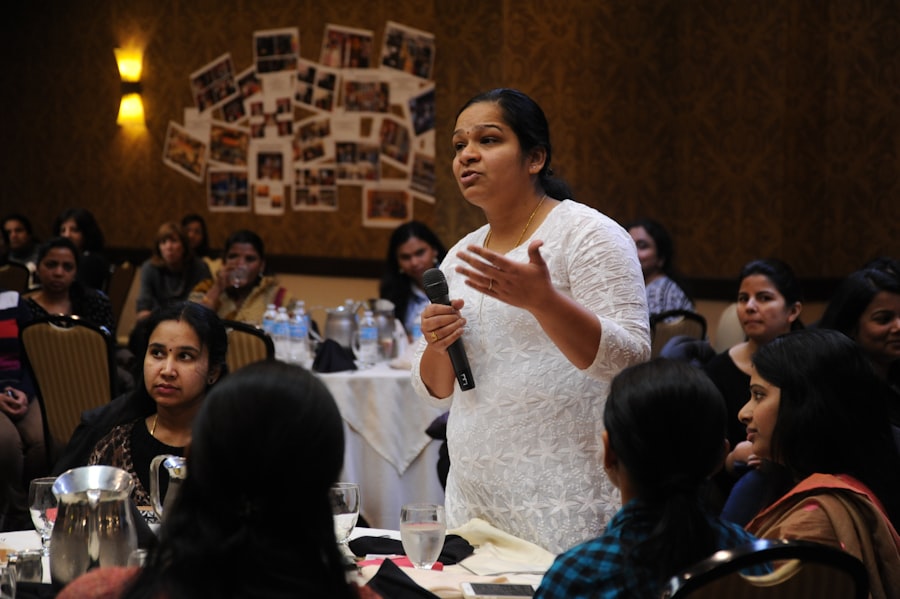Passive aggressive communication is a complex and often frustrating form of interaction that can leave you feeling confused and unsettled. At its core, this type of communication involves expressing negative feelings indirectly rather than openly addressing them. You might find yourself in situations where someone seems to agree with you on the surface but subtly undermines your requests or intentions through sarcasm, procrastination, or backhanded compliments.
This behavior can create a toxic atmosphere, making it difficult for you to navigate relationships, whether personal or professional. Recognizing passive aggressive communication is essential for maintaining your emotional well-being. It often manifests in subtle ways, such as a person agreeing to help you with a project but then failing to follow through or making snide remarks that undermine your confidence.
Key Takeaways
- Passive aggressive communication involves expressing negative feelings indirectly and often involves sarcasm, backhanded compliments, and subtle insults.
- Recognizing passive aggressive behavior can be challenging, but it often involves avoiding direct confrontation, procrastination, and subtle sabotage.
- The psychology behind passive aggression often stems from a fear of confrontation, a desire for control, and underlying feelings of resentment and anger.
- Common passive aggressive phrases and gestures include “fine, whatever,” “I guess I’ll do it since no one else will,” and intentionally forgetting to follow through on tasks.
- When responding to passive aggressive communication, it’s important to address the behavior directly, set clear boundaries, and encourage open and honest communication.
Recognizing Passive Aggressive Behavior
To effectively deal with passive aggressive behavior, you first need to recognize its signs. You may notice that someone frequently uses sarcasm or makes comments that seem innocuous but carry an underlying sting. For instance, a colleague might say, “Oh, I thought you were going to finish that report on time,” with a tone that suggests they doubt your abilities.
This kind of behavior can be disorienting, as it often leaves you questioning whether the person is genuinely upset or just joking. Another hallmark of passive aggressive behavior is procrastination or intentional inefficiency. If you ask someone to complete a task and they delay it without a valid reason, it may be a sign of passive aggression.
You might feel frustrated and helpless as you try to understand their motives. By learning to identify these behaviors, you can better prepare yourself for interactions with individuals who exhibit passive aggressive tendencies.
The Psychology Behind Passive Aggression

Understanding the psychology behind passive aggression can provide valuable insights into why some individuals resort to this form of communication. Often, passive aggressive behavior stems from an inability to express anger or frustration directly. You may find that individuals who engage in this behavior have learned to suppress their feelings due to fear of confrontation or rejection.
This internal conflict can lead them to express their discontent in indirect ways, which can be confusing for those on the receiving end. Additionally, passive aggression can be a learned behavior from childhood experiences. If someone grew up in an environment where open expression of feelings was discouraged, they might adopt passive aggressive tactics as a means of coping with their emotions.
Understanding this background can help you approach these individuals with empathy, recognizing that their behavior may not stem from malice but rather from deep-seated fears and insecurities.
Common Passive Aggressive Phrases and Gestures
| Passive Aggressive Behavior | Examples |
|---|---|
| Backhanded Compliments | “You’re so brave to wear that outfit.” |
| Silent Treatment | Ignoring someone’s presence or not responding to messages. |
| Procrastination | Deliberately delaying tasks or responsibilities. |
| Sarcasm | “Oh, great job on that project. Really top-notch work.” |
| Denial of Feelings | “I’m not mad, I’m just disappointed.” |
You may encounter various phrases and gestures that signal passive aggressive communication. Common phrases include statements like “Fine, whatever,” or “I guess I’ll just do it myself,” which convey frustration without directly addressing the issue at hand. These phrases can leave you feeling unsettled, as they often imply resentment while avoiding open confrontation.
Recognizing these verbal cues can help you navigate conversations more effectively. In addition to verbal expressions, non-verbal gestures also play a significant role in passive aggressive communication. You might notice someone rolling their eyes, sighing heavily, or giving you a dismissive wave when discussing a topic they disagree with.
These subtle cues can be just as damaging as words, creating an atmosphere of tension and misunderstanding. By being aware of both verbal and non-verbal signals, you can better interpret the intentions behind someone’s communication style.
How to Respond to Passive Aggressive Communication
When faced with passive aggressive communication, your response is crucial in determining the outcome of the interaction. One effective strategy is to address the behavior directly but calmly. For instance, if a colleague makes a sarcastic remark about your work, you might say, “I sense some frustration in your comment; can we discuss what’s bothering you?” This approach encourages open dialogue and allows the other person to express their feelings without feeling attacked.
Another effective response is to maintain your composure and not engage in the same passive aggressive tactics. Instead of retaliating with sarcasm or dismissiveness, focus on being assertive and clear about your needs and expectations. By modeling healthy communication, you create an environment where open discussions can thrive, ultimately reducing the likelihood of further passive aggressive exchanges.
Setting Boundaries with Passive Aggressive Individuals

Establishing boundaries is essential when dealing with passive aggressive individuals. You may find it helpful to communicate your limits clearly and assertively. For example, if someone consistently undermines your efforts at work, you could say, “I appreciate your input, but I need us to work collaboratively without negative comments.” Setting these boundaries helps create a framework for healthier interactions and signals that you will not tolerate passive aggressive behavior.
It’s also important to remain consistent in enforcing these boundaries. If someone crosses the line after you’ve communicated your limits, address it immediately. You might say something like, “I noticed that you made another sarcastic comment about my project; I’d prefer if we could keep our discussions constructive.” By holding individuals accountable for their actions, you reinforce the importance of respectful communication.
Effective Communication Strategies for Dealing with Passive Aggression
To navigate interactions with passive aggressive individuals successfully, consider employing effective communication strategies. One approach is to use “I” statements when expressing your feelings or concerns. For instance, instead of saying, “You always make sarcastic comments,” try saying, “I feel uncomfortable when sarcasm is used in our discussions.
Active listening is another vital strategy when dealing with passive aggression. By genuinely listening to the other person’s concerns and validating their feelings, you create an atmosphere of trust and openness. You might say something like, “I hear that you’re frustrated; let’s talk about what’s bothering you.” This approach encourages honest dialogue and can help diffuse tension in the conversation.
Confronting Passive Aggressive Behavior in a Constructive Manner
Confronting passive aggressive behavior requires a delicate balance of assertiveness and empathy. When addressing the issue, choose an appropriate time and setting where both parties can speak openly without distractions. Begin by expressing your observations without judgment; for example, “I’ve noticed that there have been some sarcastic comments lately.” This non-confrontational approach allows the other person to reflect on their behavior without feeling attacked.
Encourage them to share their feelings by asking open-ended questions like, “What’s been on your mind lately?” This invitation can lead to a more productive conversation where both parties feel heard and understood. By approaching the situation constructively, you foster an environment conducive to resolving underlying issues rather than perpetuating cycles of passive aggression.
Mastering Assertive Communication as an Alternative to Passive Aggression
Assertive communication serves as a powerful alternative to passive aggression for both parties involved. By expressing your thoughts and feelings openly and honestly while respecting others’ perspectives, you create a foundation for healthy interactions. You might practice assertiveness by stating your needs clearly: “I need feedback on this project by Friday so I can meet my deadline.” This direct approach eliminates ambiguity and encourages collaboration.
Moreover, mastering assertive communication involves recognizing your worth and standing firm in your beliefs without resorting to hostility or aggression. When you communicate assertively, you model healthy behavior for others and contribute to a more positive environment where everyone feels empowered to express themselves openly.
Overcoming Passive Aggressive Tendencies in Yourself
If you recognize passive aggressive tendencies within yourself, taking steps toward change is essential for personal growth and healthier relationships. Start by reflecting on situations where you’ve felt frustrated or angry but chose not to express those feelings directly. Acknowledging these patterns is the first step toward breaking free from them.
Consider practicing mindfulness techniques to help manage your emotions more effectively. When you feel the urge to respond passively aggressively, take a moment to pause and assess your feelings before reacting. Ask yourself what you’re truly feeling and how best to express it constructively.
By developing self-awareness and emotional regulation skills, you can gradually overcome passive aggressive tendencies and foster healthier communication habits.
Building Healthy Relationships through Open and Direct Communication
Ultimately, building healthy relationships hinges on open and direct communication. By fostering an environment where both parties feel safe expressing their thoughts and feelings honestly, you create stronger connections based on trust and understanding. Encourage open dialogue by regularly checking in with those around you about their feelings and concerns.
Additionally, practice vulnerability by sharing your own thoughts and emotions openly. When others see you modeling this behavior, they may feel more comfortable doing the same. As you cultivate an atmosphere of transparency and respect, you’ll find that relationships flourish while passive aggression diminishes, leading to more fulfilling interactions in all areas of your life.
Passive-aggressive communication is a subtle yet impactful form of expression that can often lead to misunderstandings and tension in relationships. This style of communication involves expressing negative feelings indirectly rather than openly addressing them, which can create a cycle of confusion and frustration. For those interested in exploring this topic further, an insightful article on passive-aggressive behavior can be found on the Unplugged Psych website. This resource delves into the nuances of passive-aggressive communication and offers strategies for recognizing and addressing it effectively. To read more, visit the article on Unplugged Psych.
WATCH THIS! 🧠 The 11 Manipulation Tactics That Trap Smart People
FAQs
What is passive aggressive communication?
Passive aggressive communication is a style of communication where individuals express their negative feelings and opinions indirectly, often through subtle actions, sarcasm, or avoidance.
What are some examples of passive aggressive communication?
Examples of passive aggressive communication include giving the silent treatment, making backhanded compliments, procrastinating, and expressing anger indirectly through sarcasm or jokes.
How does passive aggressive communication affect relationships?
Passive aggressive communication can lead to misunderstandings, resentment, and a breakdown in trust within relationships. It can also create a toxic and unhealthy environment.
What are the signs of passive aggressive communication?
Signs of passive aggressive communication include avoiding direct confrontation, expressing negative feelings indirectly, being overly critical, and using subtle manipulation tactics.
How can one deal with passive aggressive communication?
Dealing with passive aggressive communication involves addressing the behavior directly, setting clear boundaries, and encouraging open and honest communication. It may also involve seeking professional help or counseling.




